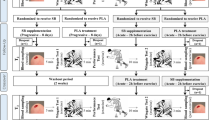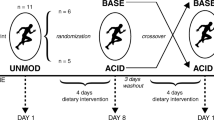Abstract
The purpose of this study was to determine the effect of oral administration of sodium bicarbonate (NaHCO3) on surface electromyogram (SEMG) activity from the vastus lateralis (VL) during repeated cycling sprints (RCS). Subjects performed two RCS tests (ten 10-s sprints) interspersed with both 30-s and 360-s recovery periods 1 h after oral administration of either NaHCO3 (RCSAlk) or CaCO3 (RCSPla) in a random counterbalanced order. Recovery periods of 360 s were set before the 5th and 9th sprints. The rate of decrease in plasma HCO −3 concentration during RCS was significantly greater in RCSAlk than in RCSPla, but the rates of decline in blood pH during the two RCS tests were similar. There was no difference between change in plasma lactate concentration in RCSAlk and that in RCSPla. Performance during RCSAlk was similar to that during RCSPla. There were no differences in oxygen uptake immediately before each cycling sprint \( ({\text{pre}}\dot{V}{\text{O}}_{2} ) \) and in SEMG activity between RCSAlk and RCSPla. In conclusion, oral administration of NaHCO3 did not affect SEMG activity from the VL. This suggests that the muscle recruitment strategy during RCS is not determined by only intramuscular pH.




Similar content being viewed by others
References
Arsac LM, Thiaudière E, Diolez P, Gerville-Réache L (2004) Parameter estimation in modeling phophocreatine recovery in human skeletal muscle. Eur J Appl Physiol 91:419–424
Ayalon A, Inbar O, Bar-Or O (1974) Relationships among measurements of explosive strength and anaerobic power. In: Nelson RC, Morehouse CA (eds) Biomechanics IV. University Park Press, Baltimore, pp 527–532
Billaut F, Basset FA, Falgairette G (2005) Muscle coordination changes during intermittent cycling sprints. Neurosci Lett 380:265–269
Bishop D, Edge J, Davis C, Goodman C (2004) Induced metabolic alkalosis affects muscle metabolism and repeated-sprint ability. Med Sci Sport Exerc 36:807–813
Bouissou P, Estrade PY, Goubel F, Guezennec CY, Serrurier B (1989) Surface EMG power spectrum and intramuscular pH in human vastus lateralis muscle during dynamic exercise. J Appl Physiol 67:1245–1249
Bruton JD, Lännergren J, Westerblad H (1998) Effects of CO2-induced acidification on the fatigue resistance of single mouse muscle fibers at 28 degrees C. J Appl Physiol 85:478–483
Cooke R, Franks K, Luciani GB, Pate E (1998) The inhibition of rabbit skeletal muscle contraction by hydrogen ions and phosphate. J Physiol 395:77–97
Costill DL, Verstappen F, Kuipers H, Janssen E, Fink W (1984) Acid-base balance during repeated bouts of exercise: influence of HCO3. Int J Sports Med 5:228–231
Enoka RM, Stuart DG (1992) Neurobiology of muscle fatigue. J Appl Physiol 72:1631–1648
Fitts RH (1994) Cellular mechanisms of muscle fatigue. Physiol Rev 74:49–94
Gaitanos GC, Nevill ME, Brooks S, Williams C (1991) Repeated bouts of sprint running after induced alkalosis. J Sports Sci 9:355–369
Gaitanos GC, Williams C, Boobis LH, Brooks S (1993) Human muscle metabolism during intermittent maximal exercise. J Appl Physiol 75:712–719
Gandevia SC (1998) Neural control in human muscle fatigue: changes in muscle afferents, motorneurones and motor cortical drive. Acta Physiol Scand 162:275–283
Godt R, Nosek TM (1989) Changes of intracellular milieu with fatigue or hypoxia depress contraction of skinned rabbit skeletal and cardiac muscle. J Physiol 412:155–180
Hagberg M (1981) Muscular endurance and surface electromyogram in isometric and dynamic exercise. J Appl Physiol 51:1–7
Harris RC, Edwards RH, Hultman E, Nordesjo LO, Nylind B, Sahlin K (1976) The time course of phosphocreatine resynthesis during recovery of the quadriceps muscle in man. Pflügers Arch 367:137–142
Heigenhauser GJF, Jones NL (1991) Bicarbonate loading. In: Lamb D, Williams M (eds) Ergogenics: enhancement of performance in exercise and sport. Brown & Benchmark, Dubuque, pp 183–212
Johnson LJ, Heigenhauser GJF, Hsia CCW, Jones NL, Wagner PD (1996) Determinants of gas exchange and acid-base balance during exercise. In: Rowell LB, Shepherd JT (eds) Handbook of physiology, section 12; exercise: regulation and integration of multiple systems. American Physiological Society, New York, pp 515–584
Jones NL, Sutton JR, Taylor R, Toews CJ (1977) Effects of pH on cardiorespiratory and metabolic responses to exercise. J Appl Physiol 43:959–964
Juel C (1998) Skeletal muscle Na+/H+ exchange in rats: pH dependency and the effect of training. Acta Physiol Scand 164:135–140
Kay D, Marino FE, Cannon J, St Clair Gibson A, Lambert MI, Noakes TD (2001) Evidence for muscular fatigue during high-intensity cycling in warm, humid conditions. Eur J Appl Physiol 84:115–121
Komi PV, Tesch P (1979) EMG frequency spectrum, muscle structure, and fatigue during dynamic contractions in man. Eur J Appl Physiol Occup Physiol 42:41–50
Lakomy HKA (1986) Measurement of work and power output using friction-loaded cycle ergometers. Ergonomics 29:509–517
Lamb GD, Stephenson DG, Bangsbo J, Juel C (2006) Lactic acid accumulation is an advantage/disadvantage during muscle activity. J Appl Physiol 100:1410–1414
Lambert EV, St Clair Gibson A, Noakes TD (2005) Complex systems model of fatigue: integrative homoeostatic control of peripheral physiological systems during exercise in humans. Br J Sports Med 39:52–62
Lind AR, Petrofsky JS (1979) Amplitude of the surface electromyograms during fatiguing isometric contraction. Muscle Nerve 2:257–264
Lindström L, Kadefors R, Peterson I (1977) An electromyographic index for localized muscle fatigue. J Appl Physiol 43:750–754
Lindström L, Magnusson R, Petersen I (1970) Muscular fatigue and action potential conduction velocity changes studied with frequency of EMG signals. Electromyography 10:341–356
Matsuura R, Ogata H, Yunoki T, Arimitsu T, Yano T (2006) Effect of blood lactate concentration and the level of oxygen uptake immediately before a cycling sprint on neuromuscular activation during repeated cycling sprints. J Physiol Anthropol 25:267–273
McCann DJ, Molé PA, Caton JR (1995) Phosphocreatine kinetics in humans during exercise and recovery. Med Sci Sports Exerc 27:378–387
Moritani T, Muro M, Nagata A (1986) Intramuscular and surface electromyogram changes during fatigue. J Appl Physiol 60:1179–1185
Moritani T, Nagata A, Muro M (1982) Electromyographic manifestation of muscular fatigue. Med Sci Sports Exerc 14:198–202
Nevill ME, Bogdanis GC, Boobis LH, Lakomy HKA, Williams C (1996) Muscle metabolism and performance during sprinting. In: Maughan RJ, Shireffs SM (eds) Biochemistry of exercise IX. Human Kinetics, Champaign, pp 243–260
Noakes TD, St Clair Gibson A, Lambert EV (2005) From catastrophe to complexity: a novel model of integrative central neural regulation of effort and fatigue during exercise in humans: summary and conclusions. Br J Sports Med 39:120–124
Pate E, Bhimani M, Franks-Skiba K, Cooke R (1995) Reduced effect of pH on skinned rabbit psoas muscle mechanics at high temperatures: implications for fatigue. J Physiol 486:689–694
Racinais S, Bishop D, Denis R, Lattier G, Mendez-Villaneuva A, Perrey S (2007) Muscle deoxygenation and neural drive to the muscle during repeated sprint cycling. Med Sci Sports Exerc 39:268–274
Rossiter HB, Ward SA, Kowalchuk JM, Howe FA, Griffith JR, Whipp BJ (2002) Dynamic asymmetry of phosphocreatine concentration and O2 uptake between the on- and off-transients of moderate- and high-intensity exercise in humans. J Physiol (Lond) 541:991–1002
Sahlin K, Söderlund K, Tonkonogi M, Hirakoba K (1997) Phosphocreatine content in single fibers of human muscle after sustained submaximal exercise. Am J Physiol 273:C172–C178
St Clair Gibson A, Lambert MI, Noakes TD (2001) Neural control of force output during maximal and submaximal exercise. Sports Med 31:637–650
St Clair Gibson A, Noakes TD (2004) Evidence for complex system integration and dynamic neural regulation of skeletal muscle recruitment during exercise in humans. Br J Sports Med 38:797–806
St Clair Gibson A, Schabort EJ, Noakes TD (2001) Reduced neuromuscular activity and force generation during prolonged cycling. Am J Physiol Regul Integr Comp Physiol 281:R187–R196
Stephens TJ, McKenna MJ, Canny BJ, Snow RJ, McConell GK (2002) Effect of sodium bicarbonate on muscle metabolism during intense endurance cycling. Med Sci Sports Exerc 34:614–621
Stulen FB, De Luca CJ (1981) Frequency parameters of the myoelectric signal as a measure of muscle conduction velocity. IEEE Trans Biomed Eng 28:515–523
Ulmer H-V (1996) Concept of an extracellular regulation of muscular metabolic rate during heavy exercise in humans by psychophysiological feedback. Experientia 52:416–420
Author information
Authors and Affiliations
Corresponding author
Rights and permissions
About this article
Cite this article
Matsuura, R., Arimitsu, T., Kimura, T. et al. Effect of oral administration of sodium bicarbonate on surface EMG activity during repeated cycling sprints. Eur J Appl Physiol 101, 409–417 (2007). https://doi.org/10.1007/s00421-007-0512-x
Accepted:
Published:
Issue Date:
DOI: https://doi.org/10.1007/s00421-007-0512-x




